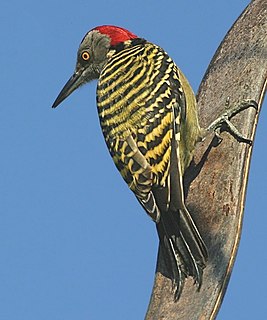
Picinae containing the true woodpeckers is one of three subfamilies that make up the woodpecker family Picidae. True woodpeckers are found over much of the world, but do not occur in Madagascar or Australasia.
The Sibley–Ahlquist taxonomy is a bird taxonomy proposed by Charles Sibley and Jon E. Ahlquist. It is based on DNA–DNA hybridization studies conducted in the late 1970s and throughout the 1980s.

Woodpeckers are part of the family Picidae, which also includes the piculets, wrynecks, and sapsuckers. Members of this family are found worldwide, except for Australia, New Guinea, New Zealand, Madagascar, and the extreme polar regions. Most species live in forests or woodland habitats, although a few species are known that live in treeless areas, such as rocky hillsides and deserts, and the Gila woodpecker specialises in exploiting cacti.
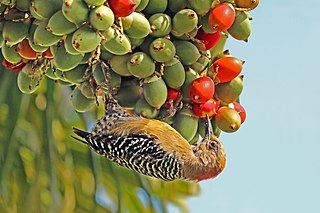
Nine families of largely arboreal birds make up the order Piciformes, the best-known of them being the Picidae, which includes the woodpeckers and close relatives. The Piciformes contain about 71 living genera with a little over 450 species, of which the Picidae make up about half.

New World barbets are near passerine birds from the family Capitonidae of the order Piciformes, which inhabit humid forests in Central and South America. They are closely related to the toucans.

Honeyguides are near passerine birds in the order Piciformes. They are also known as indicator birds, or honey birds, although the latter term is also used more narrowly to refer to species of the genus Prodotiscus. They have an Old World tropical distribution, with the greatest number of species in Africa and two in Asia. These birds are best known for their interaction with humans. Honeyguides are noted and named for one or two species that will deliberately lead humans directly to bee colonies, so that they can feast on the grubs and beeswax that are left behind.

The piculets are a distinctive subfamily, Picumninae, of small woodpeckers which occur mainly in tropical South America, with just three Asian and one African species.

Campephilus is a genus of large American woodpeckers in the family Picidae.

The rufous woodpecker is a medium-sized brown woodpecker native to South and Southeast Asia. It is short-billed, foraging in pairs on small insects, particularly ants and termites, in scrub, evergreen, and deciduous forests and is noted for building its nest within the carton nests of arboreal ants in the genus Crematogaster. It was for sometime placed in the otherwise Neotropical genus Celeus but this has been shown to be a case of evolutionary convergence and molecular phylogenetic studies support its placement in the monotypic genus Micropternus.
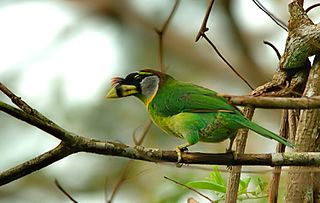
The Asian barbets are a family of bird species, the Megalaimidae, comprising two genera with 30 species native to the forests of the Indomalayan realm from Tibet to Indonesia. They were once clubbed with all barbets in the family Capitonidae but the Old World species have been found to be distinctive and are considered, along with the Lybiidae and Ramphastidae, as sister groups. In the past the species were placed in three genera, Caloramphus, Megalaima and Psilopogon, but studies show that Psilopogon to be nested within the clade of Megalaima. Since members of this clade are better treated under a single genus, they have been moved to the genus Psilopogon which was described and erected earlier than Megalaima and is therefore chosen on the basis of taxonomic priority principles. Nearly all members of the family are now in the genus Psilopogon, with the exception of the Caloramphus which is thought to have genetically diverged from the common ancestor around 21.32 million years ago. The latter species is distinct enough to warrant placement in a distinct subfamily Caloramphinae. The family name is derived from that of the genus Megalaima which means ‘large throat’, from the Greek mega and laimos.
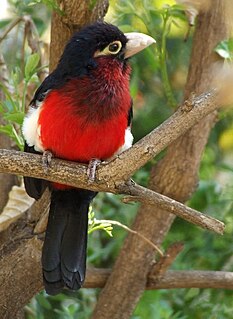
The African barbets are birds in the family Lybiidae. There are 43 species ranging from the type genus Lybius of forest interior to the tinkerbirds (Pogoniulus) of forest and scrubland. They are found throughout sub-Saharan Africa, with the exception of the far south-west of South Africa.

The black-browed barbet is an Asian barbet native to Peninsular Malaysia and Sumatra, where it inhabits foremost forests between 600 and 2,000 m altitude. It is listed as Least Concern on the IUCN Red List because of its wide distribution and stable population.

The brown-eared woodpecker is a species of bird in the family Picidae. It is native to the African tropical rainforest. There are two subspecies; P. c. caroli in the eastern part of its range and P. c. arizela, present from Guinea-Bissau in the west to Nigeria in the east. This bird has a wide range and is a common species in some areas, and the International Union for Conservation of Nature has rated its conservation status as being of "least concern".
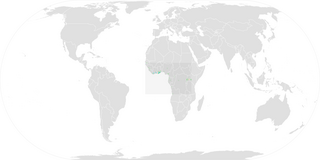
The buff-spotted woodpecker is a species of bird in the family Picidae. It is native to large parts of tropical central Africa. It has an extremely wide range and is an uncommon species, and the International Union for Conservation of Nature has rated its conservation status as being of "least concern".

Galbula is the type and largest genus of the jacamar family (Galbulidae) of piciform birds, and its suborder Galbulae. Sometimes, the Piciformes are split in two, with the Galbulae upranked to full order Galbuliformes.
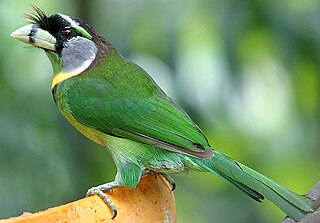
Psilopogon is a genus of Old World barbets that used to include only a single species, the fire-tufted barbet. Results of molecular phylogenetic analyses indicate that the genus is nested within an evolutionary branch consisting of Asian barbets that were formerly placed in the genus Megalaima proposed by George Robert Gray in 1841. Since Psilopogon was proposed by Salomon Müller already in 1835, this name takes priority.

The thick-billed honeyguide is a bird of the honeyguide family Indicatoridae. It has been reported interbreeding with the related lesser honeyguide and the two are sometimes treated as a single species.
Lester Leroy Short is an American ornithologist. His main research field is the order Piciformes.

Pici is one of the two suborders of the order Piciformes and includes two infraorders Ramphastides and Picides. Members of this suborder are often called "true piciforms", as the jacamars of Galbulidae and puffbirds of Bucconidae were thought to be not closely related to toucans and woodpeckers, but instead to the order Coraciiformes. However, analysis of nuclear DNA in a 2003 study placed them as a sister group to the rest of the Piciformes, also showing that the groups had developed zygodactyl feet before separating. Per Ericson and colleagues, in analysing genomic DNA, confirmed that puffbirds and jacamars were sister groups and their place in Piciformes.

Ramphastides is an infraorder of the order Piciformes that includes toucans and barbets. Formerly, the barbets have been classified in a single family, the Capitonidae. However, this has turned out to be paraphyletic with regard to toucans, which resulted in the Capitonidae being split into several families.


















